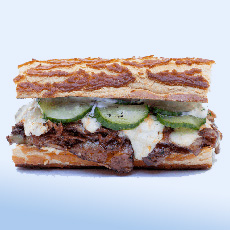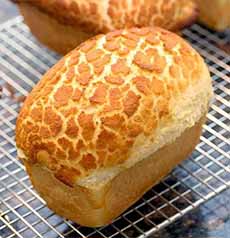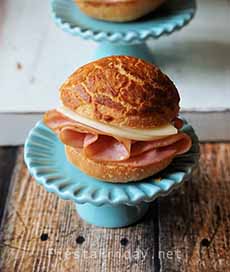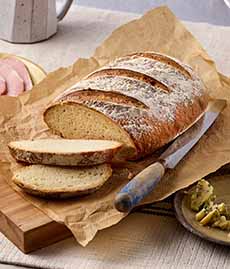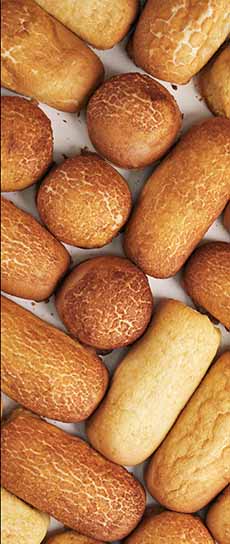Dutch Crunch Bread: What It Is & Recipes To Bake Your Own
|
|
January 14th is National Pastrami Day. We’d tucked a link from Flavor & The Menu about a pastrami sandwich onto our calendar, and when we checked it out we found something we knew nothing about: Dutch Crunch bread. First, about the pastrami sandwich in photo #1, which happens to be made on Dutch Crunch bread: Pastrami is beef brisket that has been cured, coated in spices (crushed black pepper, coriander, mustard seeds, garlic, and others), cold smoked, and then steamed. Hot Johnnie’s Dutch Crunch Pastrami Sandwich is the creation of Jonathan Young, chef/owner of pastrami smokehouse Hot Johnnie’s in San Francisco. Instead of the classic pastrami on rye, Hot Johnnie’s Dutch Crunch layers house-smoked pastrami and creamy, and melted Muenster cheese on Dutch Crunch bread, spread with house-made pepperoncini aïoli. Fresh dill and house-made pickles tie the flavors together. “Dutch Crunch is one of the most beloved types of breads in the Bay Area,” says Chef Young. “This sandwich is simple yet packed with flavor and incredible texture” [source]. It turns out that this white bread with a crunchy top descends from tiger bread, which originated in The Netherlands. In Dutch, the bread is called tijgerbrood (tiger bread) and tijgerbol (tiger roll). The earliest mention of a bread with a crispy, rice flour topping comes from the Netherlands in the early part of the 20th century [source]. Over time, it spread beyond The Netherlands and became especially popular the U.K., at both artisan bakeries and supermarket chains. In 2012, the giant grocery chain Sainsbury’s renamed the tiger bread to “giraffe bread” at the suggestion of a 3-year-old girl. Via letter to management and subsequent online petition, she astutely pointed out that the mottled pattern of the crust is much closer to a giraffe’s coat [source 1] [source 2]. (However, you can see from photo #1 that it is possible to create tiger’s stripes.) Tiger bread is begins with soft and fluffy white bloomer bread loaf (photo #5). But it gets its “tiger” pattern (or giraffe pattern, depending on your point-of-view) from a rice flour paste which is brushed on time and bakes to a distinctive crunch. Dutch Crust is the San Francisco incarnation of Tiger Bread—named because the original name (and concept) was Dutch. It’s an oblong or rectangular loaf with a crinkled, golden-brown crust that crackles when you bite it (photo #2). The crumb (the inside) is soft, molding to whatever is placed between the slices. The golden brown color is the result of a Maillard reaction* (the same browning that colors toast). The crust is made up of of rice flour, sugar, oil, water, and yeast, blended into a paste and brushed on top of the bread. When heat is applied (i.e., baking), these ingredients create a much crunchier crust. Because rice flour is free of gluten and has more and different starches than wheat flour, this paste creates the crinkle topping. Because of the absence of gluten, the top coat does not spread. Thus, while the wheat bread beneath is expanding from the heat of the oven, the rice flour paste on top dries, cracks, and crisps up to create the patterned look [source]. The appeal is not only visual, but also textural and aural (you can hear it crunch). Unless you live in the San Francisco Bay area, it’s tough to find Dutch Crunch bread. It can sometimes be found in the Pacific Northwest. On the East Coast, Wegmans grocery once sold something similar under the name “Marco Polo” bread, but it is not currently on the website. Here’s a photo from 2009—close but no cigar. We hope that bakers nationwide get hip to the opportunities Dutch Crunch—or Tiger—or Giraffe—or What Will You—presents. In the interim, we found two resources online. While we haven’t tried them, here are two options if you don’t want to bake: > The different types of sandwich: a photo glossary. > The history of the sandwich. > The different types of bread: a photo glossary. > The history of bread. |
|
|
|
||
